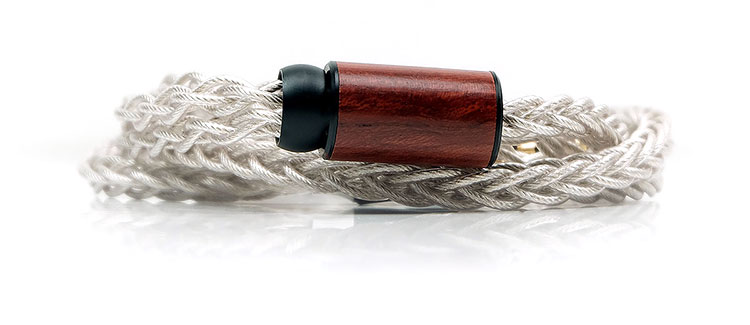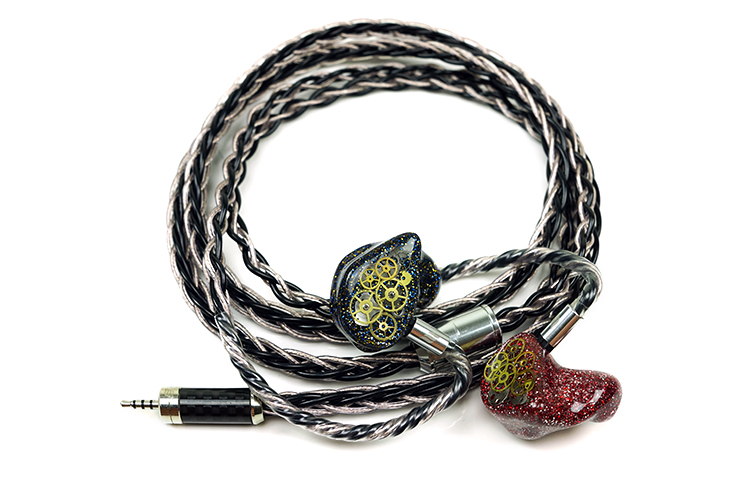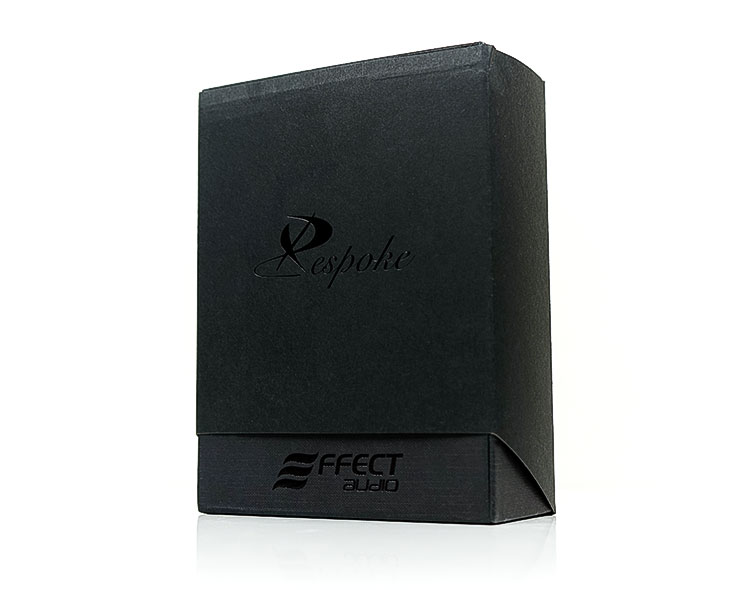Sound Impressions
First Time Upgraders
If you are coming from a stock 4-wire cable such as Plastics One or something equally as flaccid then you will be blown away by the Leonidas II Octa. No contest! You get a huge setup in dynamic range, a far more open and spacious sound and enhanced levels of volume.
Quite a lot of high-end monitors do indeed come with cables like these, be it OFC or SPC. Examples include Nobel Audio’s Khan, Jomo Audio’s Trinity, and Vision Ear’s VE8. These are generally 4-wire configurations that get you going but they gimp the sounds of otherwise technically excellent monitors. Compared to the Octa, these builds will sound overly compressed, positively veiled and soft in their impact.
The Octa will tighten up that low-end, improve the layering and critically resolve micro-detail at a much higher level. That means imaging will pan out wider, taller and deeper to produce a seductively holographic presentation.
Leonidas II Upgraders
However, if you are coming from the 4-wire Leonidas II, the differences are more nuanced than you might think. That is not to say it is not an upgrade. It most certainly is on a technical level but it is also not simply a Leonidas II x 2.
Volume
Now the first thing you will notice moving to the Leonidas II Octa is hardly a difference at all in volume levels. Normally moving from 4-wire to 8-wire results in a little volume jump. Not so with these two cables. Mind you, I did remark in the PLUSSOUND Tri-Silver cable review the gap between it and the 4-wire Leonidas II not to be that huge for volume so I shouldn’t be surprised. Just goes to show how good the Leonidas II was, to begin with.
Timbre
The second is the coloration or the timbre itself. In our Leonidas II review, we described the 4-wire as a ‘neutral to natural’ sounding with a fairly balanced presentation. It is not as punchy as aggressive as a Thor II instead of adopting a purer or smoother, almost organic timbre.
The Leonidas II Octa timbre, on the other hand, sounds a little more accurate to my ear compared to the 4-wire’s warmer sound. One of the factors behind that is the enhanced treble presence and articulation of the Octa compared to the 4-wire. It introduces a little more upper order odd-harmonic flavor to the timbre and also better treble body which in turn gives instruments such as percussion more sparkle and clarity.
Power
The third difference is low-end power. Not just in quantity but in quality. The Octa reaches much deeper than its 4-wire sibling and is also tighter and punchier sounding. It is not qute Janus levels of warmth and thickness but if you are missing some low-end welly from the 4-wire presentation then the Octa will give you that.
The additional power also affects the timbre of the Octa. Not only will you hear some additional off-harmonic clarity in higher-pitched instrumental timbre but you will also receive a stronger bass fundamental in lower-pitched notes. It really gives a huge lift in the presentation from punchier monitors such as the VE8 and Jomo Audio’s Trinity but at the same time, you will not lose one iota of Leonidas II’s famed holographic soundstage. If anything, it enhances it with additional depth and power.
‘The Chase’
A good example of the difference the better low-end performance can make is Analog 80’s Chase from their 2014 Recall album using a Lotoo PAW Gold Touch and two monitors, the Jomo Audio Trinity and Vision Ear’s VE8.
The track has this low-end fat synth beat that basically drives the rhythm of this track right the way throughout. With the 4-wire Leonidas II, you get a nice level of mid-bass punch but it really plays second fiddle to the overarching midrange core melody when it kicks-off about a minute into the track.
With the Octa, I get more sub-bass presence and detail throughout and slightly less mid-bass warmth. The power does not diminish quite in the same fashion either when that main midrange synth piano line takes over. Also, because of that additional top-end presence and air, the synth melody overlay sounds a little more realistic and clearer to my ear as well.
Staging
Staging is even better now on the Octa compared to the Leonidas II. Picture that holographic detailed soundstage that the Leonidas II was so good at and now add some additional depth and treble presence and now you are listening to the Octa.
Combine that with the slightly more accurate timbre and you get a midrange presentation that is not only more realistic and detailed sounding but also even more 3-Dimensional and open than before. Vocals in particular benefit from the Octa’s enhanced soundstage sounding even clearer than before.
Matchability
Still, a preference thing because you can find some copper cables such as the Janus that will give you a thicker sound. The Octa, much like the Leonidas II is still fundamentally about technical excellence, intricate imaging, and superlative staging.
However, this time you do get some additional power and a superbly defined sub-bass presence that will allow you to draw in different monitors that may not have made sense before. Monitors such as the Vision Ears VE8 with its hefty low-end response sounded a little flat on the Leonidas II. Not so with the Octa pairing. This is immediately punchier and ‘bigger sounding’ with a much better level of PRaT than the 4-wire alternative.
E-Stat Monitors
What I love most about that additional body and power from the Octa is how it gels with the new wave of electrostatic hybrids such as the Jomo Audio Trinity and Noble Audio’s Khan.
Now some might still prefer that slightly warmer smoother tone on the Khan when paired with the Leonidas II. The Khan has a feistier or more forward top-end than the Trinity and the Octa doesn’t soften it up quite as much as the 4-wire. However, I say let it rip with the Octa because the level of treble articulation with both the Trinity and Khan is just unreal at times.
Combine that with that enhanced low-end reach and power as well as a greater mid-range clarity and I think you will have your high-end stats monitors working at truly optimal levels.
Revisiting the Phantom
Last time around I mentioned that the Leonidas II worked some interesting things in the presentation of the Empire Ears Phantom. A little less low-end power and better instrumental separation and clarity.
This time around the Octa is actually a better pairing. You get more of that low-end prowess and lower-midrange power the Phantom is known for but also a slightly cleaner and more open midrange that I think the Phantom vocal presence really does need.
You also get bags more treble energy and headroom which I think is also quite essential to prevent the Phantom from sounding dark or lacking in air.
Select Comparisons
PLUSSOUND X8 Series Tri-Silver
$888
Technical
The Tri-Silver is another 8-wire infused with palladium though the mix of wire is different from the Leonidas II Octa. The Octa uses a palladium-plated silver UP-OCC 26AWG gauge wire in a 7-core bundled Litz type configuration. The Tri-Silver uses a 26AWG Litz Type 6 geometry with 3 types of blended silver; pure silver, gold-plated silver, and palladium-plated silver.
Builds
Both have fantastic builds, probably the best in the business right now for 8-wire. However, depending on the aspect of the build you focus on you can see where each is slightly superior to the other.
For weight and thickness of the cable, the Octa pulls ahead. The braiding is slightly tighter and the insulation slightly leaner on the Octa. The y-split barrel on the Octa is also smaller and a little more premium with the patina-style leather finish compared to the bulkier rosewood ring of the Tri-Silver. Granted you can change to a smaller alloy finish on the Tri-Silver but the leather on the Octa is still very unique for me.
The Tri-Silver, however, has the superior connector finishing with those screw lock tight barrels and no memory wire forming on the exit. The EA chrome finish barrels are shorter on the Octa but feel a little cheaper and there is some memory wire on the exit which makes them a little stiffer. The 2.5mm jack on the Octa is lighter than the Tri-Silver alternative but both have an excellent if differing finish.
Handling
One final note is microphonic performance. The handling on both is superb but the Tri-Silver just edges ahead slightly on physical noise on the wire when tapped compared to the Leonidas II Octa. This could well be a side-effect of thinner insulation on the Octa to get it a bit lighter and smaller.
Performance
Both cables target the same holographic staging effect on the performance of any good monitor but the tuning, especially the timbre, is quite different on both.
The Tri-Silver has more of a traditional silver sound to it with a slightly brighter tuning, more treble presence, and less low-end weight. The Leonidas II Octa has a richer sound, with more low-end weight and slightly less treble energy in deference to a wetter more natural sound. Thus staging is a bit grander and deeper on the Octa whereas the Tri-Silver has a bit more top-end articulation and presence.
Preferences
How you perceive both will ultimately depend on the monitor you are using and your personal preference. If you want more depth, a bit more weight on your instrumental note and a slightly wetter attack then pick the Octa. If you prefer a clean sound signature, with a neutral timbre and more treble presence then pick the Tri-Silver.
Also, your choice of IEM will come into play. In some ways, this does link to personal preference. For instance, the Vision Ears VE8 does have a very healthy level of low-end body and presence. Those who have it will naturally want a cable to play to its strengths. The tuning fit is thus more natural with the fuller-sounding Octa whereas I feel the low-end goes a bit missing with the Tri-Silver.
Whereas with the Noble Audio Khan, those looking to maximize those electrostatic highs might be more tempted with the peppier top-end of the Tri-Silver. Especially if the low-end girth is not a huge factor for you.
Effect Audio Janus Dynamic
$1399
Technical
The EA Janus is a bigger cable than the Leonidas II Octa and belongs to their Hall of Fame range. However, like the Octa, it uses palladium-plating in its mix though paired to copper rather than silver so slightly cheaper. In fact. the two-tone PVC jacket of the outside of the Janus denotes two different wires in the build of the Janus D.
The first is PPC or Palladium Plated copper and is the lighter color of the two wires in the braided design. The second is an in-house mix of gold-plated copper and a gold-alloy and is housed in the black wiring.
The bigger comes from the selection of a 24AWG 8-wire (4-4 wire split) as opposed to the 8-wire 26AWG inside the Octa. The Janus actually is a ‘4-4’ wire split between the PPC side and the EA GPC black jacket side but still technically an 8-wire build.
Build
The build on these have a few commonalities but the visuals are very different. The Octa is lighter in tone with organic and leather accents. The Janus D has a darker ‘noire’ visual aesthetic with blacks, silver, and solid metal y-splits.
Handling
The Janus D is the heavier of the two, not as tight on the braid throw, and the slightly stiffer but then that’s physics. This is a bigger cable thus will handle like a bigger cable. On the flip side, the Janus D does have a better microphonic performance than the Octa. When running both cables over a keyboard with a CIEM attached we could hear a little more noise on the wire on the Octa compared to the almost silent Janus.
Performance
Despite both having a palladium-plating this is still very much about copper versus silver. Both have excellent imaging and instrumental separation but where they differ is just how much of that imaging and separation is carried up into the treble. Here, the Leonidas II Octa has an edge with more perceptible treble energy and an airy presentation.
There are also some clear differences in the low-end tuning emphasis, instrumental timbre, and air. The Janus D has a lovely balance between its low-end and mids but both are a little thicker and more forward sounding compared to the Leonidas II Octa. The Octa pulls back a little in term of weight and produces a lighter but slightly more articulate response from top to bottom on monitors such as the VE8 and Phantom.
You will hear a bit more separation, a more holographic sound stage and enhanced treble presence and air on the Leonidas II Octa. You will hear a fatter low-end with more lower-mids instrumental body and power with the Janus Dynamic. I dare say that the low-end weight is even more emphasized with the Janus Basso than the Dynamic’s slightly more balanced approach.
Preferences
I would take the Janus D for generally u-shaped or L-shaped musical monitors that rely on a weightier low-end or those that prefer thicker richer lower-mids. Monitors such as the qdc Neptune, VE8, and the Empire Ears Phantom play to the Janus D strengths.
For the Leonidas II Octa, it performs best when the monitor has a focus on articulation and staging prowess such as the 64 Audio A18 and the tia Trio. E-stats monitors such as Jomo Audio Trinity perform really well with the Octa also which does need plenty of treble clarity and headroom to shine.
Our Verdict
If Leonidas II made me want to buy the Leonidas 1 to see what the original fuss was all about then the Leonidas II Octa creates a fuss that makes me want to sell the Leonidas II. This is the most technically brilliant cable I have heard from Effect Audio to date.
I get more of everything in terms of enhanced depth, more low-end power, and increased treble clarity. But it is not just simply a Leonidas II X2. The Octa is a little more balanced in its timbre, less warm, perhaps more accurate as a result. The enhanced treble gives you that bite and headroom which in turn helps the mids breathe just that bit more. I am impressed, a lot.
The build is still fantastic and kudos to Effect Audio for keeping the thickness of the Octa as small as possible. Maybe just a little more microphonics and less secure connectors than the PLUSSOUND Tri-Silver but it is also smaller in girth even though they have the same gauge. The patina-style leather accents on that silvery cable still seal it for me.
So who should get this behemoth of a cable? Anyone looking to upgrade from the Leonidas II looking for a bit more low-end depth and power. Also, anyone with a wide range of summit-fi monitors and wants one cable to bring out the detail and soundstage in them all. The cost may put off the casual cable buyer but for those that invest, the Octa is 100% a solid keeper.
Leonidas II Octa Specifications
- 26 AWG
- Selected UP-OCC
- Golden Ratio Palladium Plated Silver & Litz Silver Hybrid
- Septuplet Core Bundle Litz
- Individually Enameled Strands
- Superior PSquared / P-EA Plugs
- EA Ultra-Flex Jacket
- All-New Modular Y-Split Design
- Premium Selects Burnished Case











